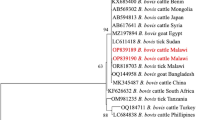Abstract.
The essential protein lysyl-tRNA synthetase (LysRS) exists in two unrelated forms, a class I and a class II-type aminoacyl-tRNA synthetase. Comparative genome sequence analysis revealed that Borrelia burgdorferi sensu lato, the etiological agent of Lyme disease, contains a class I-type LysRS, whereas its tick and mammalian hosts would be expected to contain a class II-type protein. To investigate the utility of the class I LysRS as a diagnostic target for Lyme disease, the corresponding gene (lysK) was cloned and sequenced from B. afzelii, B. garinii, and B. hermsii. These lysK sequences were then used to design a primer set that could detect and genotype B. burgdorferi sensu strictu, B. afzelii, and B. garinii in one single polymerase chain reaction, while showing no cross reactivity with examples of other Borrelia or spirochetes.
Similar content being viewed by others
Author information
Authors and Affiliations
Additional information
Electronic Publication
Rights and permissions
About this article
Cite this article
Mejlhede, N., Monthán, A., Theisen, M. et al. Differentiation of Borrelia burgdorferi sensu lato strains using class I lysyl-tRNA synthetase-encoding genes. Med Microbiol Immunol 192, 79–83 (2003). https://doi.org/10.1007/s00430-002-0149-7
Received:
Issue Date:
DOI: https://doi.org/10.1007/s00430-002-0149-7




